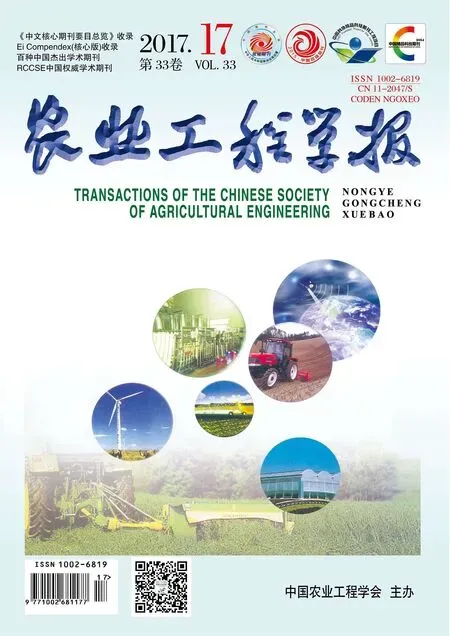基于HYDRUS-2D模型的玉米高出苗率地下滴灌开沟播种参数优选
莫 彦,李光永,蔡明坤,王 丹,徐新涵,边新洋
基于HYDRUS-2D模型的玉米高出苗率地下滴灌开沟播种参数优选
莫 彦1,2,李光永1※,蔡明坤1,王 丹1,徐新涵1,边新洋3
(1. 中国农业大学水利与土木工程学院,北京 100083;2. 中国水利水电科学研究院水利研究所,北京 100048;3. 京蓝沐禾节水装备有限公司,赤峰 024000)
开沟播种是一种可显著提高地下滴灌春玉米出苗率的新型播种方式,为了优化该技术模式,该文通过两年田间试验分析了地下滴灌玉米出苗率与灌水后种子处土壤有效饱和度(effective saturation)的关系,并基于HYDRUS-2D构建了地下滴灌开沟播种土壤水分运动模型,以90%玉米出苗率为前提,研究了不同土质和土壤初始含水率条件下3个技术参数——开沟深度、滴灌带埋深和灌水量对种子处土壤有效饱和度的影响。结果表明:1)出苗率随土壤有效饱和度线性递增,土壤有效饱和度不小于0.77时,出苗率超过90%;2)地下滴灌开沟播种HYDRUS-2D模型模拟精度较高,模拟得到的土壤有效饱和度随开沟深度增大而增大,随滴灌带埋深增大而减小;3)满足土壤有效饱和度为0.77所需的出苗水灌水量随土壤黏粒含量、土壤初始含水率和开沟深度增大而减小,随滴灌带埋深增大而增大。当表层土壤初始含水率为40%田持~60%田持时,开沟深度每增加5 cm,砂壤土的出苗水灌水量减小15~20 mm,粉壤和粉黏土的出苗水灌水量减小6~18 mm;滴灌带埋深由30 cm增大到35 cm时,砂壤土的出苗水灌水量增大16~21 mm,粉壤和粉黏土的出苗水灌水量增大4~14 mm。不同埋深和开沟深度下,当表层土壤初始含水率由40%田持增大到60%田持时,砂壤土的出苗水灌水量减小9~14 mm,粉壤和粉黏土的出苗水灌水量减小9~19 mm;4)综合考虑土壤质地、玉米根系分布、机械作业、耗能、耕作深度和土壤水深层渗漏以及土壤初始含水率,玉米地下滴灌适宜的滴灌带埋深为30~35 cm,开沟深度为10~15 cm,灌水量范围为25~67 mm。农业生产者可以根据当地实际情况对以上3个技术参数进行合理配置。
灌溉;质地;含水率;地下滴灌;开沟播种;HYDRUS-2D;土壤有效饱和度
0 引 言
地下滴灌的滴灌带一般铺设在耕作层以下[1],可以将水分和养分直接输送到作物根区,提高水分利用效率,减少水分蒸发和地表径流[2-4]。但由于重力作用,水分向上运移速度低于向下的速度[5-6],加之播种前的旋耕使地表土壤变得干松,毛细作用很弱,水分很难运移到种子处,在春旱严重地区容易导致出苗率降低。因此,在种子萌发期和幼苗期,一般采用喷灌灌溉[7],这就需要2套灌溉系统,增加了系统投资[8],对于诸如玉米和棉花等大田作物经济回报率低[9]。
地下滴灌玉米出苗受滴灌带埋深、土壤质地、土壤初始含水率等因素影响[4,9-10]。在滴灌带埋深方面,大多数学者研究了出苗后滴灌带埋深对作物生长的影响,而滴灌带埋深对作物出苗的影响鲜有研究[6,11-14]。有学者研究了滴灌带埋深和滴头流量对湿润体的影响并建立了回归模型[15]。对于滴灌带埋深影响土壤表面盐分累积从而影响作物出苗的研究也较为常见[16-17]。
近年来,HYDRUS-2D软件被广泛运用于土壤水分运动研究[18]。当土壤质地为砂壤土和黏壤土,滴灌带埋深为5~30 cm时,Skaggs等[19-21]利用土壤含水率和湿润体尺寸实测值验证了HYDRUS-2D模拟的准确性。在均质砂土中,灌水后,只有6%的水分运移到滴灌带上方[22];在均质壤土中,灌水13 mm后,湿润锋约向上运移6 cm[23];在均质黏壤土中,灌水53 mm后湿润锋向上运移17 cm[5]。Skaggs等[24-25]研究发现,在相同灌水量下,滴头流量的变化对湿润锋影响较小。当土壤初始含水率增大时,湿润体在水平和竖直方向均增大,尤其在竖直方向[20,24]。此外,一些学者基于HYDRUS-2D综合土壤质地、土壤初始含水率、2个滴头流量和滴灌带埋深对土壤蒸发、土壤水深层渗漏[26-27]和盐分积累[28]的影响来制定适宜的地下滴灌管理制度。
Mo等[29]于2017年提出了一种可以提高出苗率的地下滴灌播种方式——开沟播种,将传统玉米播种机开沟器加以改造,可形成沟深10 cm、顶宽30 cm、底宽6 cm的梯形播种沟,种子被播种在沟底下方5 cm处,与传统平地播种相比,提高了种子处的土壤初始含水率,并且由于缩短了种子和滴灌带之间的距离,使得出苗水更易于运移到种子处,出苗率显著提高。但与之配套的诸如开沟深度、滴灌带埋深和出苗水灌水量等技术参数的优化配置仍需要进一步研究。
本文基于大田试验研究,引入土壤有效饱和度(effective saturation,S)参数,研究不同出苗水灌水量下玉米出苗率和种子处土壤有效饱和度的关系;建立地下滴灌开沟播种HYDRUS-2D模型,得到出苗率达到90%时对应的S值;探索在不同土壤质地和土壤初始含水率下开沟深度、滴灌带埋深和灌水量对S的影响,获得90%以上玉米出苗率下的地下滴灌开沟播种技术参数最佳组合,以期为地下滴灌技术的推广应用提供依据。
1 材料与方法
1.1 大田试验
1.1.1 试验处理
地下滴灌田间试验于2015和2016年在内蒙古赤峰市进行。玉米生育期内有效降雨量2015年为180 mm,在2016年为251 mm。在2015年玉米出苗期(5月8日—5月30日),没有有效降雨,在2016年玉米出苗期(5月5日—5月25日),有效降雨量为24 mm,为了保证玉米出苗不受降雨影响,在降雨时用遮雨布将所有小区遮挡起来,降雨结束后再将遮雨布收起。
玉米品种为先玉335,宽窄行(80 cm×40 cm)种植,滴灌带位于窄行中央。玉米种植株距为20 cm,种植密度是83 000 株/hm2。滴灌带(NATEFIM)直径为16 mm,滴头间距为30 cm,滴头流量为1.05 L/h,滴灌带埋深=30 cm,滴灌带铺设间距为1.2 m,铺设长度为50 m,每个小区有6条滴灌带。
试验设置开沟深度和出苗水灌水量2个因素。2015年在2个开沟深度(=0 cm,=10 cm)下设置1个出苗水灌水量(25 mm),共2个处理,每个处理3个重复,共6个试验小区;2016年在2个开沟深度(=0 cm,=10 cm)下分别设置4个出苗水灌水量(15、25、45、60 mm),共8个处理。每个处理3个重复,共24个试验小区。小区面积50 m×8 m,小区随机布置。
不同开沟深度小区布置如图1所述。滴灌带埋深=30 cm。由于=0 cm处理的种子置于土表下方5 cm处,故种子相对于原状土表距离为5 cm;而=10 cm处理的种子置于沟底下方5 cm处,故种子相对于原状土表距离为15 cm[29]。出苗水灌溉时期为2015年5月10日和2016年5月7日。玉米生育期内施加尿素、磷酸一铵和氯化钾分别为572.7、221.3和217.7 kg/hm2,折合纯氮量、有效磷(P2O5)和有效钾(K2O)分别为290.0、135.0和135.0 kg/hm2,种肥和追肥(随水滴施)比例为1:4(氮肥)、1:1(磷肥)和1:1(钾肥)。
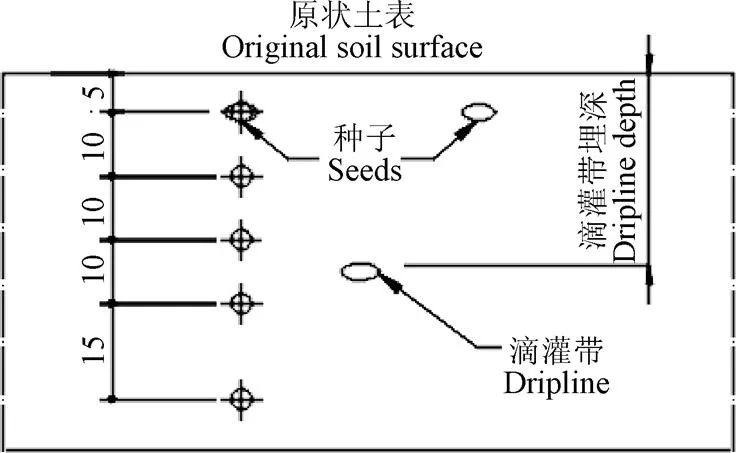
a. 开沟深度0 cm
a. Furrow depth 0 cm
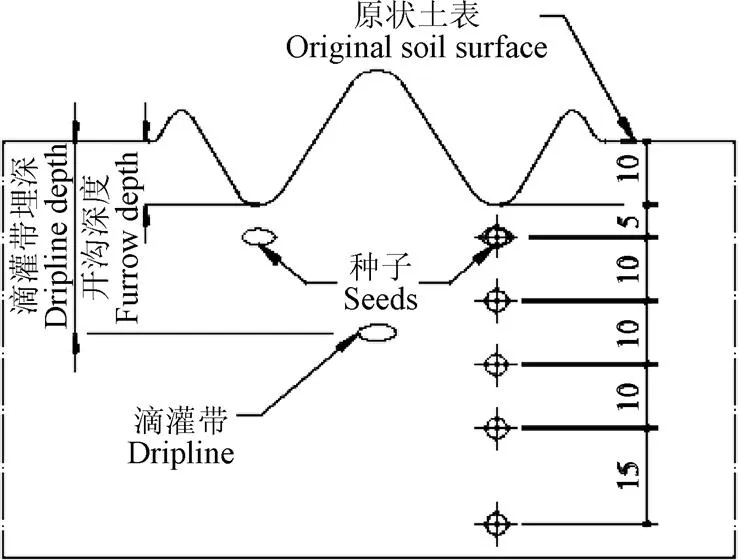
b. 开沟深度10 cm
b. Furrow depth 10 cm
注:图中数值单位为cm。
Note: Unit of data is cm.
图1 滴灌带埋深30 cm不同开沟深度处理的示意图
Fig.1 Schematic of different furrow depths with 30 cm dripline depth
1.1.2 测试指标
1)土壤含水率
在灌出苗水前和刚灌完水时,取土测试种子处和种子下方10、20、30和45 cm土壤含水率(图1)。灌出苗水前各处理土壤初始体积含水率如表1所示。开沟深度10 cm时开沟导致的垄上的土壤初始体积含水率为0.122 cm3/cm3。

表1 不同开沟深度处理的土壤初始体积含水率
2)出苗率
出苗率测试地块面积为6 m×1 m,播种后10 d(2015年5月18日和2016年5月15日)开始观测,每2 d观测1次,出苗率稳定不变时即为最终出苗率。
1.2 开沟播种数值模拟及模型验证
1.2.1 模型建立
Hydrus-2D[30]是1个可用来模拟水分、热量和溶质在二维和三维饱和或非饱和介质中运移的模型软件。当滴头间距远小于滴灌带铺设间距时,地下滴灌土壤水分运动可以简化为线源二维入渗[31]。在均匀、各向同性土壤中,水流的控制方程为Richard方程,Hydrus-2D利用Galerkin有限元法求解。由于对称性,只对滴灌带一侧土体进行模拟。
对于开沟深度=0 cm处理,计算区域为100 cm× 100 cm的正方形,如图2a所示,种子处的坐标是(20,5)。对于开沟深度=10 cm处理,土壤表面形状和尺寸与实际开沟后相同,如图2b所示,垄顶坐标是(0,−11),沟底坐标是(20,10),种子处的坐标是(20,15)。在左侧边界有1个半径0.8 cm的半圆形,代表滴头,其坐标是(0,30)。模型中设置了5个观测点,分别与图1中大田土壤含水率测试点对应。此外,在图2a坐标为(0,100)处增设观测点6,计算水分运移到该点所需灌水量W,作为在100 cm土层发生土壤水深层渗漏的依据。
1.2.2 初始和边界条件
开沟深度=0 cm和=10 cm的HYDRUS-2D模型0~60 cm土壤初始含水率根据表1进行设定,60~80 cm土壤初始含水率按40~60 cm土层设置,并假定土壤初始含水率在水平方向是均匀分布的[32]。如图2所示,模型上边界设为大气边界,下边界设为自由排水边界。模型左侧(除了滴头位置)和右侧边界设为零通量边界。滴头位置设为变通量边界,流量为1.05 L/h的滴头的水流通量根据式(1)[19]计算得到,为6.96 cm/h。

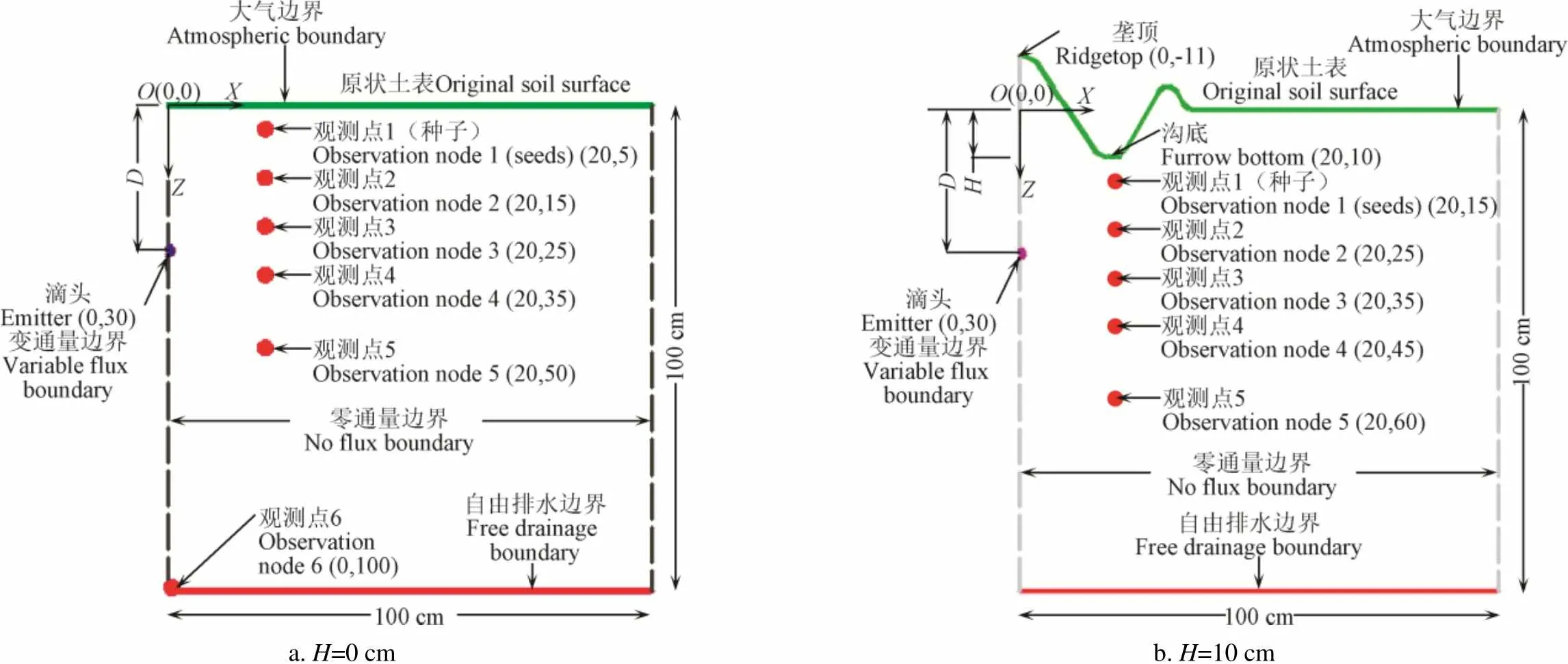
a. H=0 cmb. H=10 cm
注:为开沟深度,cm;为滴灌带埋深,cm。
Note:is furrow depth, cm;is dripline depth, cm.
图2 不同开沟深度处理HYDRUS-2D模型计算区域形状
Fig.2 Domain geometry of different furrow depths for HYDRUS-2D simulations
1.2.3 土壤水力特性
播种后,=0 cm处理以地表为基准面,=10 cm处理以沟底为基准面,用环刀取0~10,>10~20,>20~40,>40~60和>60~100 cm土层的土样,每层取3个重复。此外,=10 cm处理还取了开沟形成的土垄顶部向下0~10 cm的土样。测定各层土壤颗粒组成(用英国Malvern公司生产的Master-sizer 2000马尔文激光粒度仪测定)和土壤容重,利用HYDRUS软件中的Rosetta模型预测土壤水力特性参数。利用室内环刀法测定田间持水量(体积含水率)。
1.2.4 模型验证
采用均方根差(root mean square of error,RMSE)表征地下滴灌开沟播种HYDRUS-2D模型的模拟精度。
1.3 数值模拟试验
模拟设1种滴头流量:1.05 L/h;3种土壤质地:砂壤、粉壤和粉黏土,各土壤质地的颗粒分布、容重和田间持水量分别采用表2中相同土壤质地的平均值。

表2 不同开沟深度处理的土壤物理特性
根据2012-2015年的实测资料[29,33-35],表层土壤初始含水率取田间持水量的40%~60%,计算域底层土壤初始含水率取100%田间持水量,设土壤表层到底层初始含水率呈线性变化。模拟设5个开沟深度(=0,5,10,15和20 cm)和5个滴灌带埋深(=20,25,30,35和40 cm)。
2 结果和分析
2.1 出苗率和种子处土壤有效饱和度关系
以2015—2016年2 a的大田试验数据为基础,综合考虑土壤含水率和土壤质地,参考文献[36-37]引入土壤有效饱和度S分析灌出苗水后种子对水分的有效利用,其计算方法如式(2)。如图3所示,出苗率与S呈现显著的线性关系,2为0.70(<0.01),由图3中拟合公式可知,若使玉米地下滴灌出苗率达到90%,S需不小于0.77。郝远远等[37]在内蒙古河套灌区的试验结果认为,生育期内作物根区土壤(0~100 cm)的S为0.44~0.90时,可以基本满足小麦、玉米和葵花等作物生长需求(小麦产量6 000 kg/hm2,玉米产量12 000 kg/hm2,葵花产量3 000 kg/hm2)。利用该文中的土壤含水率推求出在文献[37]中玉米种子萌发期(5月1日-5月10日),0~10 cm土层的S约为0.73,比本文结果略小的原因可能是该文的玉米出苗率低于90%。上述出苗率和S的关系是在本试验地砂壤土下得到的,本文模拟其他土壤质地时,也采用此关系。

式中为体积含水率,θ为残余含水率,θ为饱和含水率,cm3/cm3。
图3 2015和2016年玉米出苗率和灌水结束时种子处的土壤有效饱和度的关系
Fig.3 Relationship between emergence rate and soil effective saturation at seeds after irrigation in year 2015 and 2016
2.2 开沟播种HYDRUS-2D模型验证
当出苗水灌水量为15~60 mm时,种子处和种子下方10、20、30和45 cm土壤含水率的HYDRUS-2D模拟值和大田实测值较为接近(图4)。
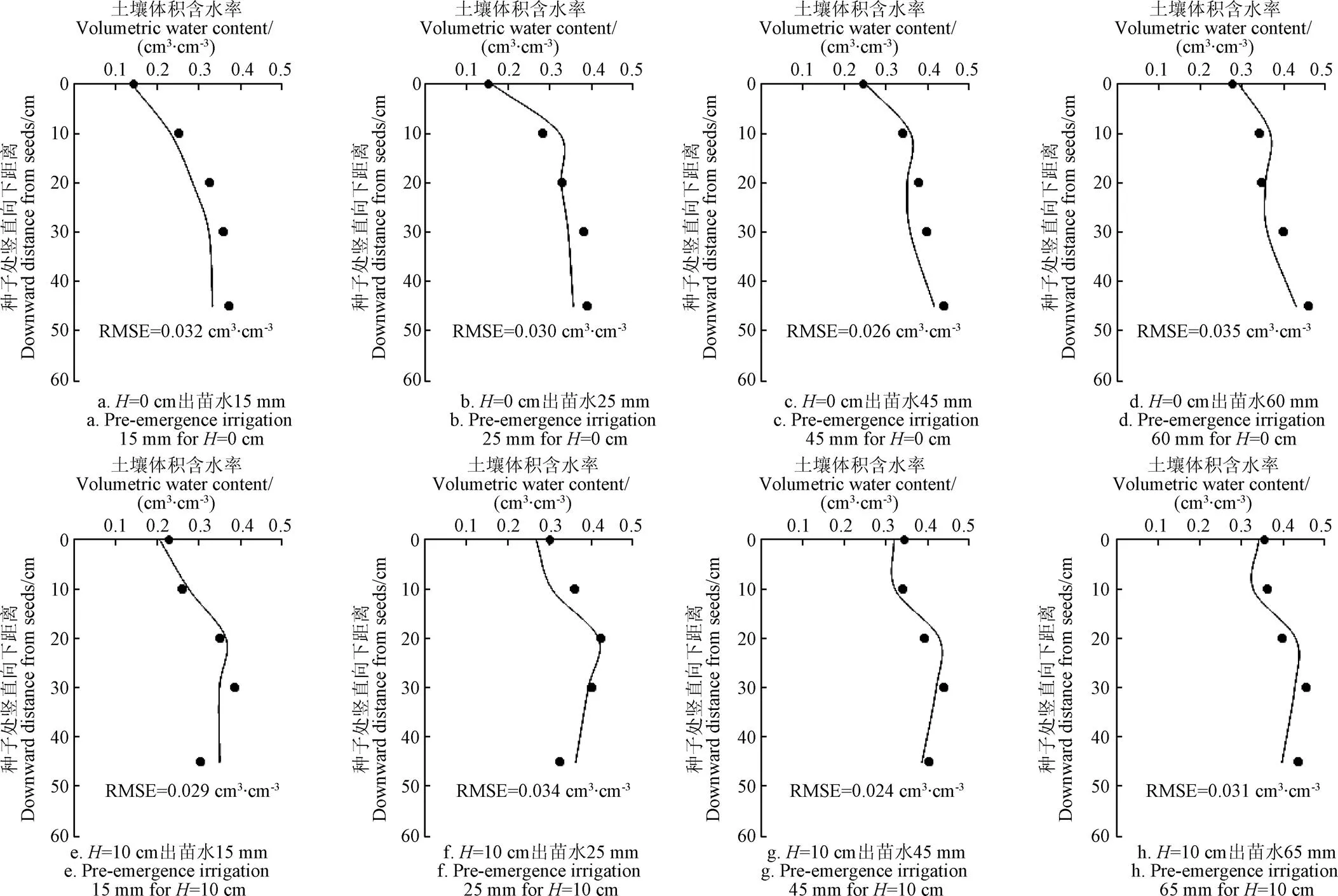
图4 不同出苗水灌水量和开沟深度下大田实测含水率和模拟值对比
由于表层土壤水分分布对环境变化很敏感[32,37],而内蒙古春天风力很强,故在种子处及其下方10 cm的土壤含水率模拟值和实测值略微有些偏差。土壤含水率模拟值和实测值的RMSE较小(0.024~0.035 cm3/cm3),与Skaggs等[19]和Kandelous等[31]的研究结果相近。故HYDRUS-2D可以用来模拟地下滴灌开沟播种土壤水分运动。
2.3 开沟深度和滴灌带埋深对种子处Se的影响
在砂壤、粉壤和粉黏土中,灌水后,和对种子处的S均有明显的影响(图5):S随增大而增大,随增大而减小。当土壤质地相同时,每增大5 cm,也需大约增大5 cm才能使S值保持不变。以粉壤土为例(见图5b),当S=0.77时,从25 cm增大到30 cm时,需要从5 cm增大到10 cm;从30 cm增大到35 cm时,需要从10 cm增大到14 cm。即在S值不变的前提下,开沟深度需要随滴灌带埋深增大而增大相同的距离,以保持滴灌带与种子之间的距离不变。
在相同开沟深度、滴灌带埋深和出苗水灌水量条件下,砂壤土的S均比粉壤土小,这是由于粗质地土壤的毛细作用相对较弱,重力作用下的水分下渗能力明显强于向上传输能力,故砂壤土中种子处土壤含水率较低[25,22,38-40]。
灌水45 mm后,当S为0.77时,在砂壤土中,滴灌带埋深为20~25 cm,对应的开沟深度为12~18 cm(见图5a);在粉壤土和粉黏土中,由于水分向上传输能力比砂壤土强,在相同开沟深度下,滴灌带可以埋设到更深的位置,或在相同滴灌带埋深下,减小开沟深度,这2种土壤质地下满足S=0.77的滴灌带埋深分别为25~40和20~40 cm,对应的开沟深度分别为5~18和0~19 cm(见图5b和5c)。
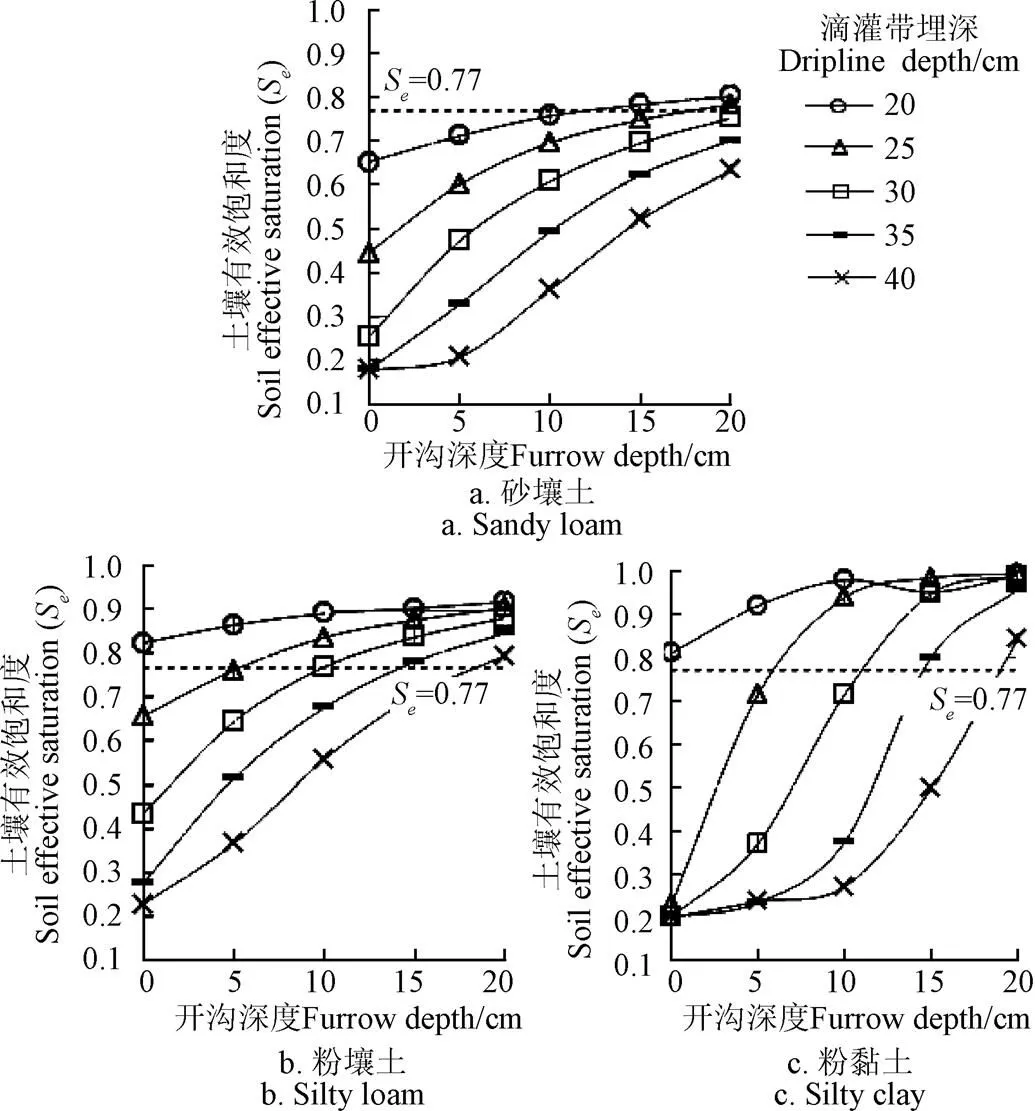
注:灌水45 mm,土壤表层到计算域底层初始含水率为40%~100%田持。
2.4 灌水量对种子处土壤有效饱和度的影响
当滴灌带埋深30 cm时,S随灌水量的变化如图6所示。当灌水量大于某一临界值W(水分运移到种子处所需灌水量,位于图6中各条曲线的拐点处)时,S随灌水量增大而增大。当开沟深度()减小时,需要增大灌水量使得S不变。以粉壤土为例(见图6b),当S=0.77时,若由20 cm减小到15 cm,灌水量需要增大7 mm,若由10 cm减小到5 cm,灌水量需要增大15 mm。
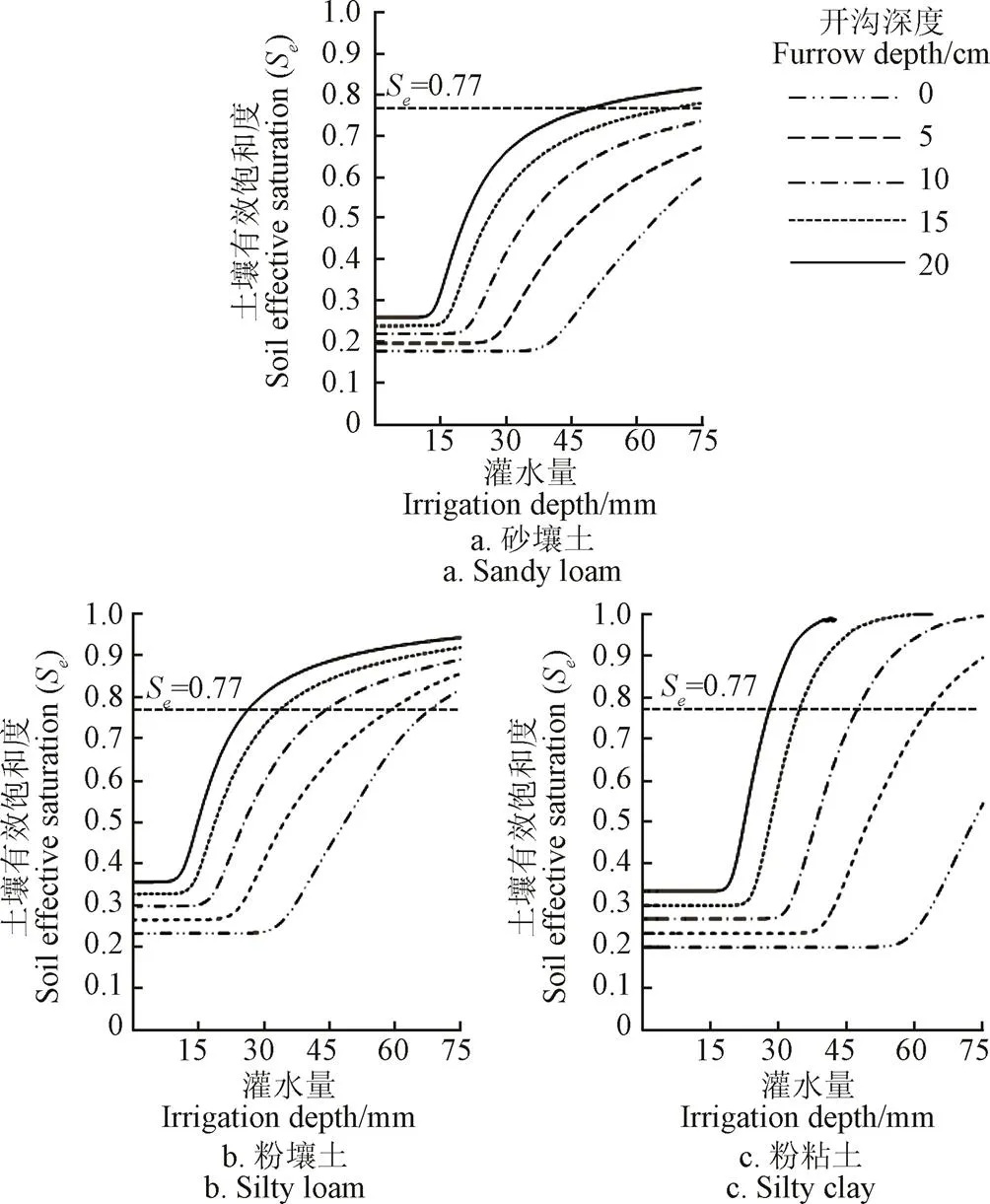
注:滴灌带埋深30 cm,土壤表层到计算域底层初始含水率为40%~100%田间持水量。
将玉米出苗率达到90%时所需灌水量定义为W,图6中各曲线与S=0.77相交点对应的灌水量是表层土壤初始含水率为40%田持、滴灌带埋深为30 cm下的W。不同土壤质地、初始含水率、和的W值如表3所示。
W随增大而减小。对于砂壤土,当=30 cm时,在10~20 cm范围内每增加5 cm,W减小15~20 mm;对于粉壤和粉黏土,在2种滴灌带埋深下,在0~20 cm范围内每增加5 cm,粉壤土的W减小6~15 mm,粉黏土减小7~18 mm。W随增大而增大。当由30 cm增大到35 cm时,对于砂壤土,当为20 cm时,W增大16~21 mm;对于粉壤和粉黏土,当为10~20 cm时,W增大4~14 mm。
W随土壤初始含水率增大而减小。当土壤表层初始含水率由40%田持增加到60%田持时,对于砂壤土,在满足S为0.77条件的情况中(为30 cm,为15~20 cm以及为35 cm,为20 cm),W减小9~14 mm;对于粉壤和粉黏土,W减小9~19 mm。
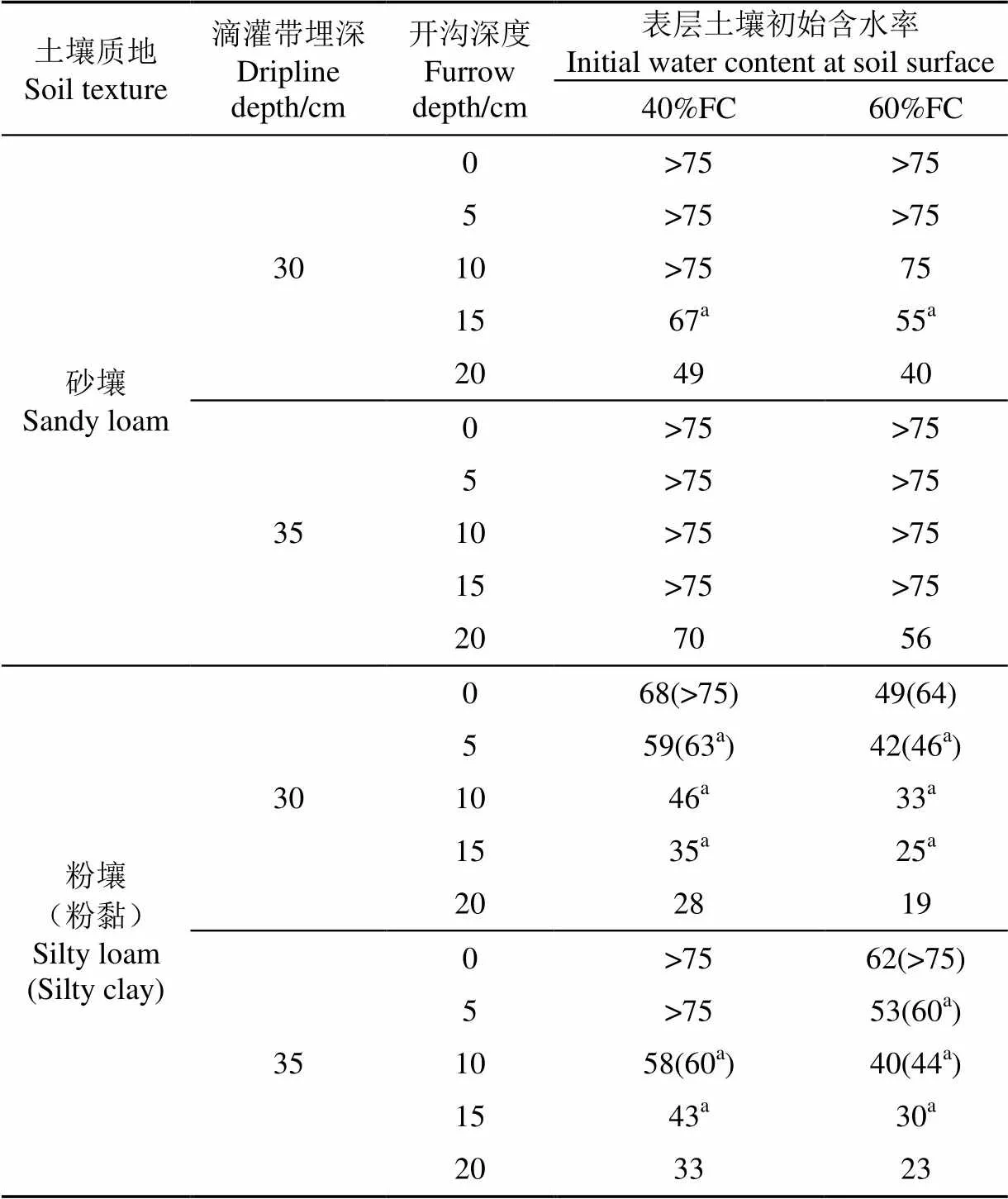
表3 基于有效饱和度0.77的地下滴灌开沟播种灌水量
注:a推荐使用。FC,田间持水量。
Note:arecommended combinations. FC, field water holding capacity.
当土壤初始含水率、滴灌带埋深和开沟深度相同时,相较于粉壤土或粉黏土,在砂壤土需要多灌水21~42 mm才能满足玉米出苗率达到90%的水分需求。
滴灌带埋深的确定应考虑玉米根系分布、耕作深度和土壤水深层渗漏,开沟深度应考虑土壤质地、机械作业与耗能,灌水量取决于滴灌带埋深、开沟深度、土壤质地以及土壤初始含水率。灌水量过大,水分运移到地表下边界,造成水分深层渗漏;开沟深度过大,机械作业耗能较大或由于土壤质地、机具原因无法实现(土质松散,开沟时沟壁容易坍塌)。综合考虑上述因素,从表3中可以得出,对于砂壤土,推荐的技术参数组合为开沟深度15 cm,滴灌带埋深30 cm,灌水量55~67 mm(取决于地表土壤初始含水率);粉壤土适宜的开沟深度为10~15 cm,滴灌带埋深为30~35 cm,灌水量为25~46 mm;粉黏土适宜的开沟深度为5~15 cm,滴灌带埋深为30~35 cm,灌水量为25~63 mm。农业生产者可以根据当地情况对以上技术参数组合进行选择。
3 结 论
本文通过2015-2016年2 a的大田试验,明确了玉米出苗率与灌水后种子处的土壤有效饱和度(S)的线性关系,发现出苗率大于90%时,S不小于0.77。在此基础上,运用地下滴灌开沟播种HYDRUS-2D模型研究开沟播种技术参数开沟深度、滴灌带埋深和灌水量对S的影响。得到如下结论:1)S随开沟深度和灌水量的增大而增大,随滴灌带埋深增大而减小;2)使玉米出苗率达到90%时所需的灌水量随土壤黏粒含量、开沟深度和土壤初始含水率增大而减小,随滴灌带埋深增大而增大;3)考虑土壤质地、玉米根系分布、机械作业、耗能、耕作深度和土壤水深层渗漏以及土壤初始含水率,玉米地下适宜的滴灌带埋深为30~35 cm, 开沟深度为10~15 cm,出苗水灌水量范围为25~67 mm。
本文参照已有研究,综合考虑土壤质地和土壤水分含量,引用土壤有效饱和度来描述地下滴灌开沟播种条件下的玉米出苗率变化,土壤有效饱和度中的饱和含水率和残余含水率可通过土壤颗粒分布和Rosetta模型预测出来,方便快捷。土壤有效饱和度与土壤有效水存在一定相关,但在实际生产中,土壤有效水是更容易被理解和可操作的参数指标,建议进一步的研究根据土壤有效水进行地下滴灌开沟播种技术参数的优化配置。
[1] Camp C R, Lamm F R. Irrigation systems, subsurface drip[M]. Encyclopedia of Water Science. New York: Marcel Dekker, Inc, 2003: 560-564.
[2] Phene C J. Drip irrigation saves water[C]//Proc Conservation 90, The National Conference and Exposition Offering Water Supply Solutions for the 1990s, Phoenix, 1990: 645-650.
[3] Lamm F R, Stone L R, Manges H L, et al. Optimum lateral spacing for subsurface drip-irrigated corn[J]. Transactions of the ASAE, 1997, 40: 1021-1027.
[4] Lamm F R, Trooien T P. Subsurface drip irrigation for corn production: A review of 10 years of research in Kansas[J]. Irrigation Science, 2003, 22: 195-200.
[5] Kandelous M M, Šimůnek J. Numerical simulations of water movement in a subsurface drip irrigation system under field and laboratory conditions using HYDRUS-2D[J]. Agricultural Water Management, 2010, 97(7): 1070-1076.
[6] Lamm F R, Trooien T P. Dripline depth effects on corn production when crop establishment is nonlimiting[J]. Applied Engineering in Agriculture, 2005, 21(5): 835-840.
[7] Schiavon M, Serena M, Leinauer B, et al. Seeding date and irrigation system effects on establishment of warm-season turfgrasses[J]. Agronomy Journal, 2015, 107: 880-886.
[8] Hillel D. Salinity Management for Sustainable Irrigation: Integrating Science, Environment and Economics[M]. Washington: World Bank Publications, 2000.
[9] Lamm F R, Bordovsky J P, Schwankl L J, et al. Subsurface drip irrigation: Status of the technology in 2010[J]. Transactions of the ASAE, 2012, 55: 483-491.
[10] Charlesworth P B, Muirhead W A. Crop establishment using subsurface drip irrigation: A comparison of point and area sources[J]. Irrigation Science, 2003, 22: 171-176.
[11] Enciso J M, Colaizzi P D, Multer W L. Economic analysis of subsurface drip irrigation lateral spacing and installation depth for cotton[J]. Transactions of the ASAE, 2005, 48(1): 197-204.
[12] Lamm F R, Kheira A A A, Trooien T P. Sunflower, soybean, and grain sorghum crop production as affected by dripline depth[J]. Applied Engineering in Agriculture, 2010, 26: 873-882.
[13] Pablo R G, O'Neill M K, McCaslin B D, et al. Evaluation of corn grain yield and water use efficiency using subsurface drip irrigation[J]. Journal of Sustainable Agriculture, 2007, 30: 153-172.
[14] Patel N, Rajput T B S. Effect of drip tape placement depth and irrigation level on yield of potato[J]. Agricultural Water Management, 2007, 88: 209-223.
[15] Al-Mefleh N K, Abu-Zreig M. Field evaluation of arid soils wetting pattern in subsurface drip irrigation scheme[J]. Clean-Soil Air Water, 2013, 41(7): 651-656.
[16] Oron G, DeMalach Y, Gillerman L, et al. Improved saline-water use under subsurface drip irrigation[J]. Agricultural Water Management, 1999, 39(1): 19-33.
[17] Roberts T L, White S A, Warrick A W, et al. Tape depth and germination method influence patterns of salt accumulation with subsurface drip irrigation[J]. Agricultural Water Management, 2008, 95(6): 669-677.
[18] Šimůnek J, Genuchten M T V, Šejna M. Recent developments and applications of the HYDRUS computer software packages[J]. Vadose Zone Journal, 2016, 15(7):1-25.
[19] Skaggs T H, Trout T J, Šimůnek J, et al. Comparison of HYDRUS-2D simulations of drip irrigation with experimental observations[J]. Journal of Irrigation and Drainage Engineering, 2004, 130(4): 304-310.
[20] Provenzano G. Using HYDRUS-2D simulation model to evaluate wetted soil volume in subsurface drip irrigation systems[J]. Journal of Irrigation and Drainage Engineering, 2007, 133(4): 342-349.
[21] Kandelous M M, Šimůnek J. Numerical simulations of water movement in a subsurface drip irrigation system under field and laboratory conditions using HYDRUS-2D[J]. Agricultural Water Management, 2010, 97(7): 1070-1076.
[22] Cote C M, Bristow K L, Charlesworth P B, et al. Analysis of soil wetting and solute transport in subsurface trickle irrigation[J]. Irrigation Science, 2003, 22(3/4): 143-156.
[23] Rodríguez-Sinobas L, Gil M, Sánchez R, et al. Evaluation of drip and subsurface drip irrigation in a uniform loamy soil[J]. Soil Science, 2012, 177(2): 147-152.
[24] Skaggs T H, Trout T J, Rothfuss Y. Drip irrigation water distribution patterns: Effects of emitter rate, pulsing, and antecedent water[J]. Soil Science Society of America Journal, 2010, 74(6): 1886-1896.
[25] Elmaloglou S, Diamantopoulos E. Simulation of soil water dynamics under subsurface drip irrigation from line sources[J]. Agricultural Water Management, 2009, 96(11): 1587-1595.
[26] Phogat V, Šimůnek J, Skewes M A, et al. Improving the estimation of evaporation by the FAO-56 dual crop coefficient approach under subsurface drip irrigation[J]. Agricultural Water Management, 2016, 178: 189-200.
[27] Xi Benye, Wang Ping, Fu Teng, et al. Optimal coupling combinations among discharge rate, lateral depth and irrigation frequency for subsurface drip-irrigated triploid populous tomentosa pulp plantation[J]. Life Science Journal:Acta Zhengzhou University Overseas Edition, 2013, 10(1): 4466-4476.
[28] Roberts T, Lazarovitch N, Warrick A W, et al. Modeling salt accumulation with subsurface drip irrigation using HYDRUS-2D[J]. Soil Science Society of America Journal, 2009, 73(1): 233-240.
[29] Mo Yan, Li Guangyong, Wang Dan. A sowing method for subsurface drip irrigation that increases the emergence rate, yield, and water use efficiency in spring corn[J]. Agricultural Water Management, 2017, 179: 288-295.
[30] Šimůnek J, Šejna M, van Genuchten M T. The HYDRUS-2D Software Package for Simulating the Two-dimensional Movement of Water, Heat, and Multiple Solutes in Variably-saturated Media: Version 2.0[M]. California: US Salinity Laboratory, Agricultural Research Service, US Department of Agriculture, 1999.
[31] Kandelous M M, Šimůnek J, van Genuchten M T, et al. Soil water content distributions between two emitters of a subsurface drip irrigation system[J]. Soil Science Society of America Journal, 2011, 75: 488-497.
[32] Xi B, Bloomberg M, Watt M S, et al. Modeling growth response to soil water availability simulated by HYDRUS for a mature triploid populous tomentosa plantation located on the North China Plain[J]. Agricultural Water Management, 2016, 176: 243-254.
[33] 米尔古丽·吾拉孜别克.内蒙古赤峰地区玉米滴灌适宜的种植模式田间试验研究[D].北京:中国农业大学,2013.
Mierguli·Wulazibieke. The Cultivation Pattern of Maize Matching to Trickle Irrigation in the Chifeng Region[D]. Beijing: China Agricultural University, 2013. (in Chinese with English abstract)
[34] 康静. 内蒙古东北地区玉米覆膜灌溉的效应研究[D]. 北京:中国农业大学,2014.
Kang Jing. The Effects of Maize Growth under Mulched Drip Irrigation in the Northeast Inner Mongolia Region[D]. Beijing: China Agricultural University, 2014. (in Chinese with English abstract)
[35] 袁江杰. 地下滴灌不同滴灌带类型与灌溉制度对玉米生长的影响[D]. 北京:中国农业大学,2015. Yuan Jiangjie. The Effects of Different Subsurface Drip Tape Types and Irrigation Scheduling on Maize Growth[D]. Beijing: China Agricultural University, 2015. (in Chinese with English abstract)
[36] 吴元芝,黄明斌.基于Hydrus-1D模型的玉米根系吸水影响因素分析[J].农业工程学报,2011,27(增刊2):66-73.
Wu Yuanzhi, Huang Mingbin. Analysis of influential factors for maize root water uptake based on Hydrus-1D model[J]. Transactions of the Chinese Society of Agricultural Engineering (Transactions of the CSAE), 2011, 27(Supp.2): 66-73. (in Chinese with English abstract)
[37] 郝远远,徐旭,任东阳,等. 河套灌区土壤水盐和作物生长的HYDRUS-EPIC模型分布式模拟[J]. 农业工程学报,2015(11):110-116.
Hao Yuanyuan, Xu Xu, Ren Dongyang, et al. Distributed modeling of soil water-salt dynamics and crop yields based on HYDRUS-EPIC model in Hetao Irrigation District[J]. Transactions of the Chinese Society of Agricultural Engineering (Transactions of the CSAE), 2015(11): 110-116. (in Chinese with English abstract)
[38] 王建东,龚时宏,马晓鹏,等. 地下滴灌条件下水热运移数学模型与验证[J]. 水利学报,2010,41(3):368-373.
Wang Jiandong, Gong Shihong, Ma Xiaopeng, et al. Verification and application of mathematical model for simulating water flow and heat transport in subsurface drip irrigation[J]. Journal of Hydraulic Engineering, 2010, 41(3): 368-373. (in Chinese with English abstract)
[39] Diamantopoulos E, Elmaloglou S. The effect of drip line placement on soil water dynamics in the case of surface and subsurface drip irrigation[J]. Irrigation and Drainage, 2012, 61(5): 622-630.
[40] Thorburn P J, Cook F J, Bristow K L. Soil-dependent wetting from trickle emitters: Implications for system design and management[J]. Irrigation Science, 2003, 22(3/4): 121-127.
[41] 李久生,杨风艳,栗岩峰. 层状土壤质地对地下滴灌水氮分布的影响[J]. 农业工程学报,2009,25(7):25-31.
Li Jiusheng, Yang Fengyan, Li Yanfeng. Water and nitrogen distribution under subsurface drip fertigation as affected by layered-textural soils[J]. Transactions of the Chinese Society of Agricultural Engineering (Transactions of the CSAE), 2009, 25(7): 25-31. (in Chinese with English abstract)
Selection of suitable technical parameters for alternate row/bed planting with high maize emergence under subsurface drip irrigation based on HYDRUS-2D model
Mo Yan1,2, Li Guangyong1※, Cai Mingkun1, Wang Dan1, Xu Xinhan1, Bian Xinyang3
(1.&,,100083,;2.,,100048,;3.,024000,)
Subsurface drip irrigation (SDI) is an advanced water-saving irrigation method. Alternate row/bed planting is a sowing technique with a 10 cm deep trapezoidal furrow; seeds are then sown in 5 cm deep soil below the furrow bottom. It can significantly improve the germination of spring maize under subsurface drip irrigation. To optimize this technology, 2-year field experiments were performed in Chifeng, Inner-Mongolia, China to study the relationship between the emergence rate of spring maize and soil effective saturation of soil at the location of the seeds after different pre-emergence irrigation amounts from 15 to 60 mm. A HYDRUS-2D model was established to obtain soil effective saturation when seed germination rate reached 90% and then to investigate effect of furrow depth, dripline depth, and irrigation amount in the conditions of different soil texture and initial water content on soil effective saturation in order to obtain best technique parameters combination for seed germination. The irrigation amount was 15, 25, 45 and 60 mm; the furrow depth was 0 and 10 cm; the dripline depth was 30 cm. The germination rate was obtained when the seed germination kept stabilized. The results showed that the maize germination rate increased linearly with soil effective saturation (2=0.70,<0.01). The HYDRUS-2D model simulation results had a high agreement with the measured soil water content with the root mean square error of 0.024-0.035 cm3/cm3). The soil effective saturation was not less than 0.77 for 90% of germination rate. The simulation results showed that the soil effective saturation increased with the increase of furrow depth and decreased with the increase of dripline depth. The required irrigation amount to meet the effective saturation of 0.77 decreased with the increase of soil clay content due to the larger hydraulic conductivity of the fine textured soil. The required irrigation amount to meet the effective saturation of 0.77 also decreased with the increase of initial soil water content and furrow depth, and increased with the increase of dripline depth. When the initial water content of the surface soil was 40%-60% field water holding capacity, the required irrigation amount to meet the effective saturation of 0.77 decreased by 15-20 mm for sandy loam, by 6-15 mm for silty loam and by 7-18 mm for silty clay respectively, with the increase of furrow depth by 5 cm. When the dripline depth increased from 30 to 35 cm, the required irrigation amount to meet the effective saturation of 0.77 increased by 16-21 mm for sandy loam, and by 4-14 mm for silty loam and silty clay. Under the different furrow depths and dripline depths, when the initial water content of surface soil increased from 40% to 60% of the field capacity, the required irrigation amount to meet the effective saturation of 0.77 decreased by 9-14 mm for sandy loam, and decreased by 9-19 mm for silty loam and silty clay. Considering the spring maize root distribution, cultivation and deep percolation, the dripline depth should be 30 and 35 cm; considering the soil texture, mechanical operation and energy consumption, the furrow depth should be 10 and 15 cm. Within the range of furrow depth and dripline depth mentioned above, the optimal irrigation amount was 25-67 mm. The study gives agricultural managers a guideline to determine the optimal combination of the 3 parameters.
irrigation; texture; water content; subsurface drip irrigation; alternate row/bed planting; HYDRUS-2D; soil effective saturation
10.11975/j.issn.1002-6819.2017.17.014
S275
A
1002-6819(2017)-17-0105-08
2017-04-01
2017-08-10
国家十二五科技支撑计划课题(2014BAD12B05)
莫 彦,博士生,主要从事节水灌溉理论与新技术研究。北京 中国农业大学水利与土木工程学院,100083。Email:moyansdi@163.com
李光永,教授,博士生导师,主要从事节水灌溉理论与新技术和水资源高效利用等研究。北京 中国农业大学水利与土木工程学院,100083。Email:lgycau@163.com

